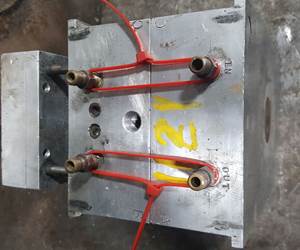Think Big
Simply accessing monitoring data online, in real time, can help you address underperforming tools and build new ones when needed.
We have all heard of the Internet of Things and Big Data. Simply stated, the Internet of Things refers to the ability of devices to connect to the Internet. Big Data refers to our ability to collect and analyze the data that is generated by these devices and turn it into actionable data. Actionable data can then be used to drive our decisions and optimize our results.
One example of how the Internet of Things and Big Data have been combined to optimize results is illustrated by General Electric in its endeavor to literally power our economy.
GE has developed a system that is used by wind farms to optimize output. Data from sensors located on each windmill are combined with real-time weather conditions and electrical needs information to determine when and how to run each windmill. Using this system has led to efficiency gains of five percent from existing wind farms. In this scenario, each windmill is a node on the network (the power grid) that generates data that is then used to drive decisions and optimize results.
Other operations also are using the Internet of Things and Big Data to reduce labor costs while making better decisions. For example, when tool cribs are used to replenish cutting tools, someone does a “milk-run” and physically counts the number of end mills, taps or drills that are usually stored in each drawer. New items are then ordered based on the tool crib attendant’s opinion of what should be in inventory. At a minimum, systems like this are costly and highly subjective, and frequently lead to tooling shortages.
In many shops today, however, cutting tools are dispensed from a vending machine. Just like the windmills in the previous example, the vending machine becomes a node on a network that automatically places an order to ensure that the shop always has a sufficient amount of tooling available.
These technologies have been applied towards countless industries; however, there has been limited impact within the world of production.
Big Data Keeps Production on Target
Mold manufacturers and molders can realize multiple advantages by employing these con-
cepts within a mold monitoring system created specifically for production tooling. Such a system consists of three components. The first is a mold monitor—a small, low-cost, battery-powered device that is installed on a plastic injection mold. It records each time the mold is cycled and calculates average cycle times and efficiency measures for preceding weeks.
The second component of the system is a press module (also known as a radio frequency transmitter) that is installed on each molding press and wirelessly communicates with the third component, a “gateway” that is installed in each molding facility. The gateway connects via Ethernet to transmit a mold’s data in real time to a secure, remote database. From there, customers can log into a website and view information for each mold they have connected to the system, and they can do it without any geographic limitations.
What information is available? The monitoring system can be configured to provide real-time alerts when a mold is not operating within user-defined limits. For example, a user can set required preventive maintenance (PM) intervals and be notified if a mold is approaching required PM or if the mold is overdue for PM. A notes section allows users to record what has been done to the mold during maintenance. Real-time performance measures, such as cycle time and efficiency, are also tracked, and users are informed, in real time, if a mold is not performing within predefined limits.
In this system, each mold is a node on a network. Each of these nodes has information that can be acquired from it. The data that is generated by it is used, in real time, to drive the decisions made by each of the mold’s stakeholders. This is the application of Big Data concepts and the Internet of Things to molds.
Big Data and Mold Maintenance
One way injection molding companies can use the data provided by a mold monitoring system is to plan and schedule PM for molds, even at multiple manufacturing plants. This offers the shop real-time visibility of current and upcoming PM needs for its molds. This information then can also aid in the decision-making process.
Here is an example of how one OEM analyzed cycle-time trends for existing tools from reports generated by its monitoring system. The manufacturer noted that, as a mold aged, its cycle times consistently increased. In one instance, it also found that the amount of curing time required to keep the molded part within tolerance also increased as the mold aged. Upon further examination, the molder discovered that the cooling system in the plant “contained a lot of junk.” As molds cycled, their cooling systems became impeded by corrosion, which impacted the molds’ ability to cool. In response, the molder simply increased cure times for the molded parts.
After the problem was correctly identified and addressed through a maintenance program, cycle times for each mold were greatly reduced; in fact, many of the molds achieved cycle times they had not reached since their initial runs. In the end, this OEM instituted a waterline maintenance program that has driven real productivity gains and, in at least one case, decreased the need to build additional molds.
Another way a company may want to capitalize on the data provided by a monitoring system is to simply monitor its assets. For example, a mold asset manager may need to track the condition and PM needs for a large fleet of molds for which he is responsible. Complicating this task is the fact that these molds may be spread throughout the country, requiring a lot of time to review their status and conditions. With a mold monitoring system in place, this job can be done much more efficiently. A remote mold monitoring system enables a shop to view the condition of a fleet of molds by logging into a website that provides real-time transparency, decreasing the need to travel to the location of each mold.
Big Data Moving Forward
Early adopters of mold monitoring systems are already tracking their molds in real time to determine maintenance needs and monitor output, and therefore ensure that production requirements are being met. This enables them to proactively address issues before they become major problems that impact the supply chain. They are afforded this increased visibility of their molds through an Internet connection.
The need to collect and analyze injection mold data is a concept that is here to stay. Molding press manufacturers are promoting their presses’ monitoring capabilities, and the use of integrated ERP systems is increasing. A mold monitoring system offers the benefits of real-time monitoring of injection molds.
Related Content
How to Use Scientific Maintenance for More Accurate Mold and Part Troubleshooting
Discover how adopting scientific maintenance approaches helps improve mold lifespan, minimize failures, and optimize production outcomes.
Read MoreThink Safety: Eliminate Hazards Throughout the Shop
The tooling community is taking advantage of new products for safer mold shops and molding facilities.
Read MoreLaser Welding Versus Micro Welding
The latest battle in finely detailed restoration/repair of mold materials.
Read MoreWhat You Should Know About Injection Mold Safety Straps
Every mold should have one in order to be safe and OSHA compliant.
Read MoreRead Next
How to Use Strategic Planning Tools, Data to Manage the Human Side of Business
Q&A with Marion Wells, MMT EAB member and founder of Human Asset Management.
Read MoreAre You a Moldmaker Considering 3D Printing? Consider the 3D Printing Workshop at NPE2024
Presentations will cover 3D printing for mold tooling, material innovation, product development, bridge production and full-scale, high-volume additive manufacturing.
Read MoreReasons to Use Fiber Lasers for Mold Cleaning
Fiber lasers offer a simplicity, speed, control and portability, minimizing mold cleaning risks.
Read More






















